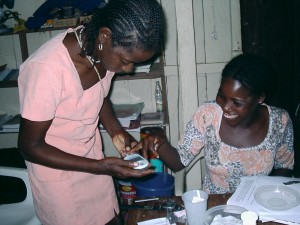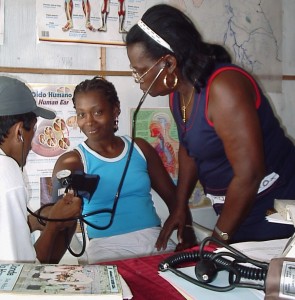Where There Is No NCD Specialist

By Zena Herman, Hesperian Health Guides
Frontline health workers have proven their value as caregivers for maternal and newborn health, vaccination programs, malaria, and as community educators on nutrition, hygiene and other health issues. As the global disease burden shifts from communicable to non-communicable diseases (NCDs) such as diabetes, heart disease, cancer, and chronic respiratory diseases, community health workers and other frontline health workers will be called upon again to address these concerns.
The increase in NCDs rates is alarming. Half the deaths worldwide are currently due to NCDs, and the disease burden is poised to increase 17% over the next decade. Dispelling a myth that NCDs are diseases of affluence, 80% of deaths from NCDs occur in low- and middle-income countries—countries with already over-burdened health systems that are the least prepared to handle such a drastic increase in demand for services.
It’s easy to get lost in these statistics and forget the human suffering behind the numbers: countless women and men who can no longer provide for their families because a limb was amputated due to diabetes complications, who suffer from incredible pain while fighting cancer without access to treatment or pain medications, who are trapped in the bitter cycle of poverty that is both a cause and an effect of these diseases.
Most of the current global dialogue is directed at needed changes at policy and advocacy levels to tackle NCDs more effectively. Yet, seemingly absent from the conversation is discussion of the role of community health workers and their incredible potential to help their communities fight against NCDs. Few programs are training CHWs to play meaningful roles in the prevention, diagnosis, and management of NCDs, and a lack of empowering and accessible health information targeted to CHWs is hindering progress.
Hesperian’s grassroots partners have requested that we develop health content on NCDs as part of the 21st century edition of our classic primary care manual Where There Is No Doctor. NCDs were not so prevalent when the book was written in the 1970s, and our partners are demanding practical information for addressing these issues within their communities now. The New Where There Is No Doctor will contain information on diabetes, hypertension, cancer, chronic respiratory illness and mental health – groundbreaking because it will be targeted to CHWs.
Among the groups addressing NCDs at a community level, we have learned an invaluable amount from the experience of the trailblazing Latino Health Access (LHA) in Santa Ana, Calif. Latino Health Access has developed a promotora (community health worker) model to take on diabetes and other issues, and build resilience among Latinos in Orange County, an area with jaw-dropping wealth and health disparities.
The promotoras are themselves community members with diabetes who have learned how to manage their disease, stay healthy and educate and support others. The clinical outcomes are excellent, far more successful than diabetes programs in nearby hospitals run by doctors and nurses. LHA attributes this accomplishment to seeing a peer with diabetes take charge of her life, inspiring other community members to believe they can do it too. Promotoras have become skilled community organizers reaching out to their neighbors in grocery stores, schools and laundromats to promote diabetes self-management, healthy cooking and exercise classes.
Each success makes the promotoras bolder, yet more aware of how hard it is to live a healthy life in an unhealthy neighborhood that has more liquor stores than playgrounds. Instead of just giving empty advice to “exercise more” in neighborhoods lacking green space but decorated with signs that read “no running,” “no skating,” and “no trespassing,” LHA’s promotoras opened a beautiful park in the most park-poor zip code of Orange County.
Latino Health Access provides one example of how community health workers can be key to successful diabetes management and prevention. Many other NCDs are also best addressed by social support to make lifestyle changes, rather than only through medical intervention. Frontline health workers like these CHWs are best placed to support these struggles posed by chronic disease, and find solutions that inspire the community to change the conditions that contribute to sickness.
Chapters on diabetes and cancer from The New Where There Is No Doctor will be available online through Hesperian’s website in late 2014 – and we hope it can contribute to better equip frontline health workers with the knowledge they need to tackle the disease burden of their communities in the 21st century.


